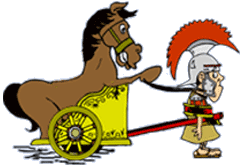Circus Maximus
Background: Circus Maximus is an ancient Roman chariot racing stadium. It was built on the land between Palatine and Aventine hills in Rome, Italy. Circus Maximus was the largest stadium in the entire Roman Empire and was used as a model for the construction of other stadiums across the Roman Empire.

It is believed that Lucius Tarquinius Priscus, the fifth Roman king built Circus Maximus in late 7th or early 6th century BC. Circus is also mentioned by historians as the site of the Consualia festival held by the founding king of Rome, Romulus. He invited his Sabine neighbors to enjoy horse racing and drinking while his men abducted young Sabine women. These women were forced to marry Roman men.

Use: The Circus was built mainly for entertainment purposes. The most popular event held at the site was the chariot race which was witnessed by a huge crowd. Apart from the chariot racing, the stadium was also used for the celebration of religious events and holding public games during festivals. Special games were also held to celebrate victory in wars. These celebrations were called ‘ludi’ and were held for a varying duration of time. Some ‘ludi’ were held for just one day while other lasted for many days.
Historians have also written of wild beasts hunts arranged in the circus for public. After the construction of Colosseum and Stadium of Domitian, Circus Maximus was primarily used for chariot racing; while gladiator games and small scale wild beast hunts were held in the Colosseum. However, Circus Maximus was still used for large scale animal hunting shows. After the rise of Christianity as state religion of Roman Empire, Circus Maximus started to lose on events held there. By mid 6th century AD, the venue was no longer used. The last known race was held in 549 AD by Totila, King of Ostrogoths.

Subsequent Use and Present Status: After the 6th century AD, the stadium was no longer in use and started to suffer from decay and damage. Thieves stole building material which damaged the structure greatly. As a result of flooding, lower tiers of seating gradually got buried into wet alluvial soil and it is believed that the actual track remains buried under a layer of six meter thick soil.
In 11th century the site was occupied by residential complexes. It is also reported that the stadium was used as a market garden in 15th century AD. The site is now used as a park area and is regularly used for holding music concerts and public gatherings. Popular music bands like Genesis, Rolling Stones and Dura Duran have performed in Circus Maximus. The stadium was also used as the venue for the victory celebration after Italy won the 2006 FIFA world cup in Germany.

Structure: Circus Maximus is six hundred and twenty one meters long and hundred and eighteen meters wide. There are two turns at the either ends of the racing circuit. The venue could accommodate around hundred and fifty thousand people into seating tiers that ran almost the entire length of the circuit.
Many thousands more could witness the events while standing on the nearby hills. After fire damaged the structure many times, Emperor Trajan rebuilt the structure with stones. Historians report that twelve four or two horse chariots could simultaneously be released on the track. Most of the races had seven laps in total.



